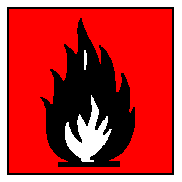International Chemical Safety Cards
| VINYLIDENE CHLORIDE | ICSC: 0083 |
VINYLIDENE CHLORIDE |
 |
 |
| TYPES OF HAZARD/ EXPOSURE |
ACUTE HAZARDS/ SYMPTOMS |
PREVENTION | FIRST AID/ FIRE FIGHTING |
| FIRE | Extremely flammable. Gives off
irritating or toxic fumes (or gases) in a fire. |
NO open flames, NO sparks, and
NO smoking. |
Powder, water spray, foam,
carbon dioxide. |
| EXPLOSION | Vapour/air mixtures are
explosive. Vinyl chloride monomer vapours are uninhibited and may form polymers in vents
or flame arresters of storage tanks, resulting in blockage of vents. |
Closed system, ventilation,
explosion-proof electrical equipment and lighting. Use non-sparking handtools. |
In case of fire: keep drums,
etc., cool by spraying with water. Combat fire from a sheltered position. |
| EXPOSURE | |
STRICT HYGIENE! |
|
| INHALATION | Dizziness. Drowsiness.
Unconsciousness. |
Ventilation, local exhaust, or
breathing protection. |
Fresh air, rest. Artificial
respiration if indicated. Refer for medical attention. |
| SKIN | Redness. Skin burns. |
Protective gloves. Protective
clothing. |
Remove contaminated clothes.
Rinse and then wash skin with water and soap. |
| EYES | Redness. Pain. |
Safety goggles, or eye
protection in combination with breathing protection. |
First rinse with plenty of water
for several minutes (remove contact lenses if easily possible), then take to a doctor. |
| INGESTION | Abdominal pain. Sore throat
(further see Inhalation). |
Do not eat, drink, or smoke
during work. Wash hands before eating. |
Rinse mouth. Do NOT induce
vomiting. Give plenty of water to drink. Rest. |
| SPILLAGE DISPOSAL | STORAGE | PACKAGING & LABELLING | ||
| Evacuate danger area! Consult an
expert! Collect leaking and spilled liquid in sealable containers as far as possible.
Absorb remaining liquid in sand or inert absorbent and remove to safe place (extra
personal protection: complete protective clothing including self-contained breathing
apparatus). |
Fireproof. Separated from
incompatible materials (see Chemical Dangers). Cool. Keep in the dark. Store only if
stabilized. |
Airtight. Unbreakable packaging;
put breakable packaging into closed unbreakable container. IMO: Marine Pollutant F+ symbol Xn symbol R: 12-20-40 S: 7-16-29 Note: D UN Hazard Class: 3 UN Packing Group: I |
||
| SEE IMPORTANT INFORMATION ON BACK | ||||
|
||||